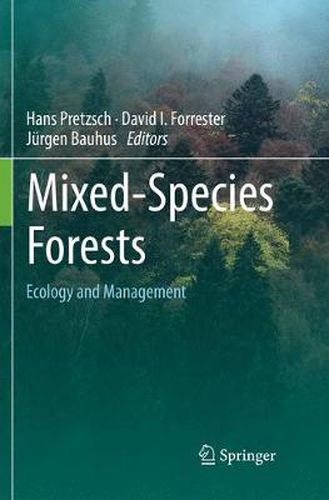Readings Newsletter
Become a Readings Member to make your shopping experience even easier.
Sign in or sign up for free!
You’re not far away from qualifying for FREE standard shipping within Australia
You’ve qualified for FREE standard shipping within Australia
The cart is loading…






This textbook offers a detailed overview of the current state of knowledge concerning the ecology and management of compositionally and structurally diverse forests. It provides answers to central questions such as:
What are the scientific concepts used to assess
the growth, dynamics and functioning of mixed-species forests, how
generalizable are they, and what kind of experiments are necessary to develop
them further? How do mixed-species stands compare with
monocultures in relation to productivity, wood quality, and ecological stability
in the face of stress and disturbances? How are the effects of species mixtures on ecosystem functioning influenced by the
particular species composition, site conditions, and stand structure? How does any over- or underyielding at the forest-stand
level emerge from the tree and organ level, and what are the main
mechanisms behind mixing effects? How can our current scientific understanding of
mixed-species forests be integrated into silvicultural concepts as well as
practical forest management and planning? Do the ecological characteristics of
mixed-species stands also translate into economic differences between
mixtures and monocultures?
In addition, the book addresses experimental designs and analytical approaches to study mixed-species forests and provides extensive empirical information, general concepts, models, and management approaches for mixed-species forests. As such, it offers a valuable resource for students, scientists and educators, as well as professional forest planners, managers, and consultants.
$9.00 standard shipping within Australia
FREE standard shipping within Australia for orders over $100.00
Express & International shipping calculated at checkout
This textbook offers a detailed overview of the current state of knowledge concerning the ecology and management of compositionally and structurally diverse forests. It provides answers to central questions such as:
What are the scientific concepts used to assess
the growth, dynamics and functioning of mixed-species forests, how
generalizable are they, and what kind of experiments are necessary to develop
them further? How do mixed-species stands compare with
monocultures in relation to productivity, wood quality, and ecological stability
in the face of stress and disturbances? How are the effects of species mixtures on ecosystem functioning influenced by the
particular species composition, site conditions, and stand structure? How does any over- or underyielding at the forest-stand
level emerge from the tree and organ level, and what are the main
mechanisms behind mixing effects? How can our current scientific understanding of
mixed-species forests be integrated into silvicultural concepts as well as
practical forest management and planning? Do the ecological characteristics of
mixed-species stands also translate into economic differences between
mixtures and monocultures?
In addition, the book addresses experimental designs and analytical approaches to study mixed-species forests and provides extensive empirical information, general concepts, models, and management approaches for mixed-species forests. As such, it offers a valuable resource for students, scientists and educators, as well as professional forest planners, managers, and consultants.